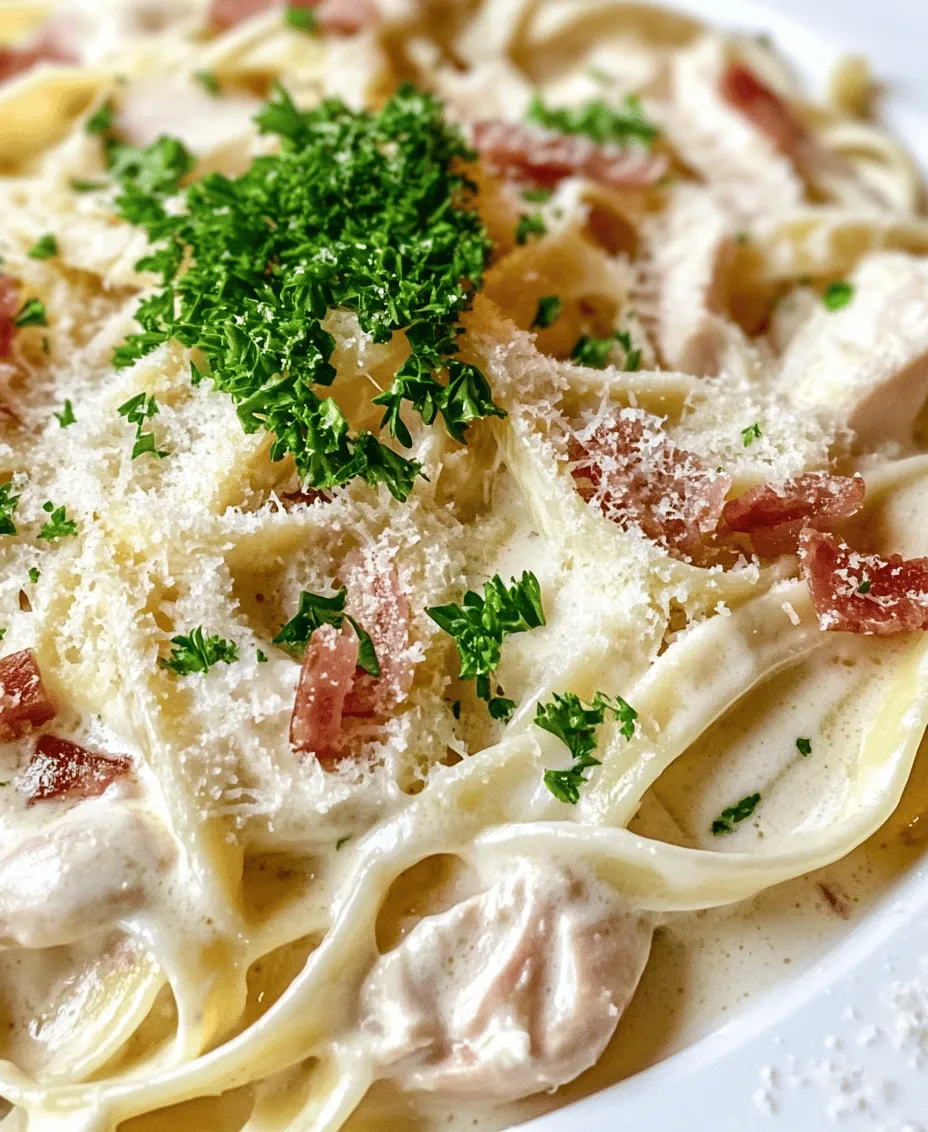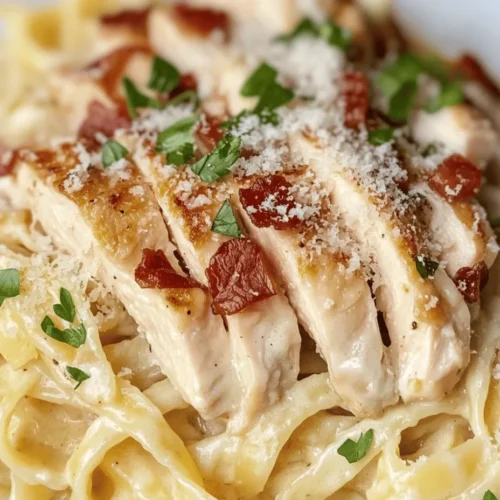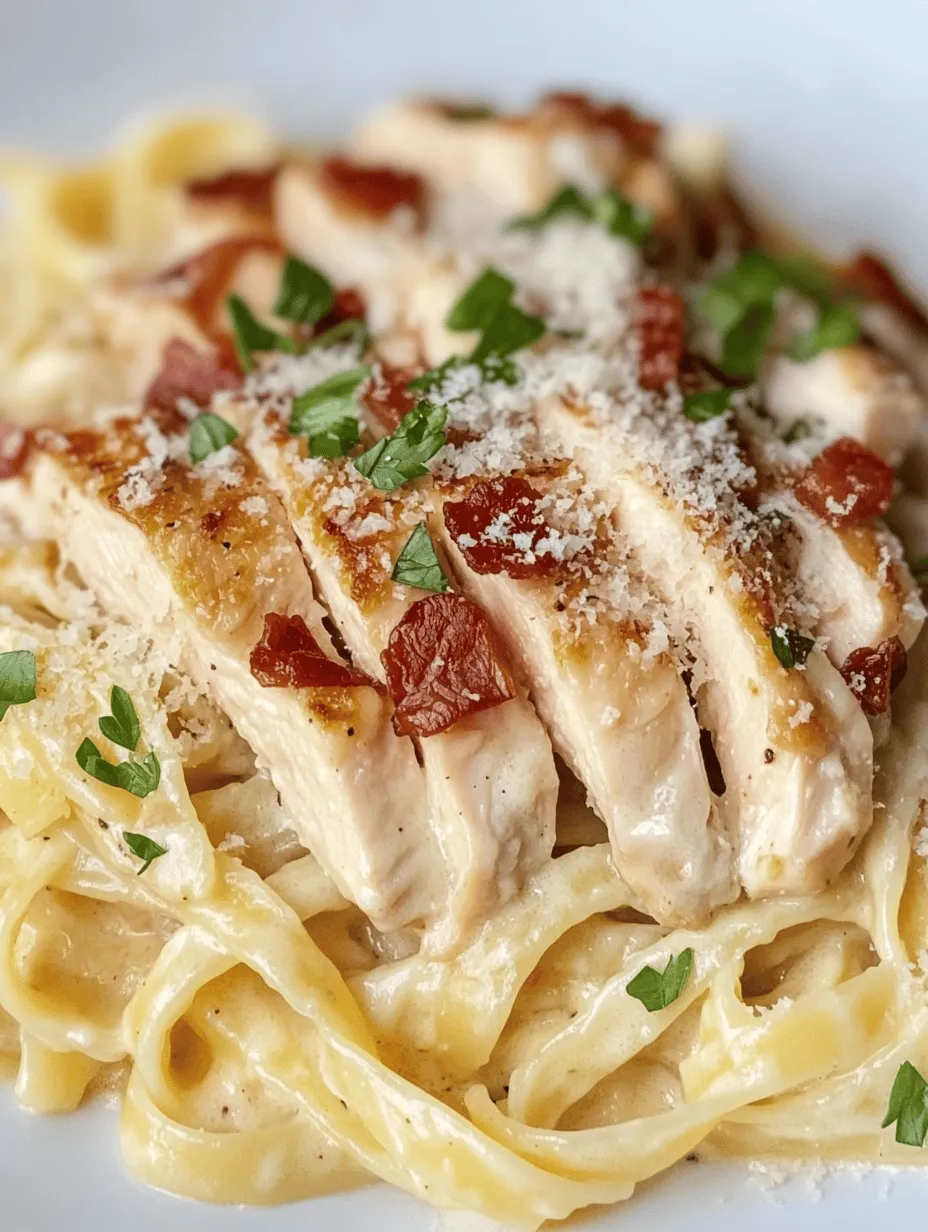Introduction
Chicken Carbonara is a dish that beautifully merges the rich, comforting flavors of traditional Italian cuisine with a modern twist that makes it accessible and delightful for home cooks. While the classic recipe typically features guanciale—a type of cured meat from the pig’s cheek—this variation substitutes chicken, creating a lighter yet equally satisfying option. The result is a creamy, savory dish that is perfect for a weeknight dinner or a special occasion.
The origins of Carbonara are somewhat murky, but it is widely believed to have originated in the Lazio region of Italy, particularly in Rome. The dish has gained immense popularity around the world, thanks to its simplicity and the delectable combination of flavors. The creamy sauce, made from eggs, cheese, and pepper, clings to the pasta, creating a harmonious blend that is both rich and comforting.
In this comprehensive guide, we will delve into the ingredients that make up the best-ever Chicken Carbonara, provide step-by-step cooking instructions, and share tips to ensure that your dish turns out perfectly every time. Whether you’re a seasoned chef or a beginner in the kitchen, this recipe will have you impressing family and friends with your culinary skills.
Understanding the Ingredients
To create a truly exceptional Chicken Carbonara, it’s essential to understand the key ingredients that contribute to the dish’s flavor and texture. Let’s break down these components.
The Foundation of Flavor: Pasta Selection
The choice of pasta is crucial when making Chicken Carbonara. While traditional recipes often call for spaghetti, we recommend using fettuccine for a heartier bite. Fettuccine’s wider surface area allows it to hold more sauce, ensuring that every bite is rich and flavorful. However, if you prefer spaghetti, feel free to stick with this classic choice.
When cooking pasta, achieving the right texture is essential. The term “al dente” refers to pasta that is cooked until it is firm to the bite, providing a pleasant chewiness. To achieve al dente pasta:
1. Bring a large pot of salted water to a rolling boil.
2. Add the pasta and cook according to the package instructions, but start checking for doneness a minute or two before the suggested time.
3. Once the pasta is al dente, reserve about a cup of the pasta cooking water before draining it. This starchy water will help thicken and emulsify the sauce later.
Protein Choice: Chicken vs. Traditional Options
In this Chicken Carbonara recipe, we are using boneless, skinless chicken breasts as our protein source. This choice offers several advantages:
– Healthier Option: Chicken breast is leaner than traditional pancetta or guanciale, making the dish lighter while still being satisfying.
– Flavor Absorption: Chicken readily absorbs flavors from the other ingredients, allowing it to complement the creamy sauce beautifully.
While pancetta and guanciale are delicious and add a distinct flavor, using chicken allows for a versatile dish that can appeal to a wider audience, including those who prefer healthier options.
Essential Flavor Enhancers
Several key ingredients play a vital role in enhancing the flavor profile of Chicken Carbonara:
– Pancetta or Bacon: While our recipe highlights chicken, incorporating a bit of pancetta or bacon can add depth and smokiness. If you choose to include it, sauté the diced pancetta alongside the chicken to render its fat, adding a rich flavor to the dish.
– Garlic: This aromatic ingredient is a staple in Italian cooking. It provides a fragrant base that elevates the overall taste of the sauce. Fresh garlic should be minced finely and sautéed until fragrant, but be careful not to burn it, as burnt garlic can impart a bitter taste.
– Freshly Grated Parmesan Cheese: The creaminess of the sauce is largely attributed to cheese. Always opt for freshly grated Parmesan rather than pre-grated cheese, as it melts better and offers a more robust flavor. The cheese should be added at the end of cooking to create a creamy consistency.
Seasoning Essentials
To bring out the best flavors in your Chicken Carbonara, proper seasoning is a must.
– Salt and Black Pepper: These essential seasonings help balance the rich flavors of the dish. Be cautious with the salt, especially if you’re using pancetta, as it can be quite salty on its own. Start with a light hand and adjust to taste.
– Fresh Herbs: A sprinkle of freshly chopped parsley not only adds a pop of color but also brightens the dish’s rich flavors. The herb’s freshness can help cut through the creaminess of the sauce.
Step-by-Step Cooking Instructions
Now that we’ve established the importance of the ingredients, it’s time to dive into the cooking process. Follow these detailed instructions to prepare your Chicken Carbonara.
Preparing the Pasta
1. Boil the Pasta: Begin by bringing a large pot of salted water to a rolling boil. The salt not only flavors the pasta but also helps to enhance the overall dish. Once boiling, add your fettuccine or spaghetti and cook according to the package instructions for al dente doneness.
2. Reserve Pasta Cooking Water: Before draining the pasta, be sure to reserve about a cup of the starchy cooking water. This will be crucial for achieving the desired sauce consistency later.
3. Drain the Pasta: After the pasta has cooked, drain it in a colander. Do not rinse the pasta, as this will wash away the starch that helps the sauce adhere to the noodles.
Cooking Chicken to Perfection
1. Prepare the Chicken: While the pasta is cooking, take your boneless, skinless chicken breasts and season them with salt and black pepper on both sides.
2. Sauté the Chicken: In a large skillet over medium heat, add a drizzle of olive oil. Once heated, add the seasoned chicken breasts. Cook for about 6-7 minutes on each side, or until they are golden brown and cooked through. The internal temperature should reach 165°F (75°C).
3. Remove and Rest: Once cooked, remove the chicken from the skillet and let it rest on a cutting board for a few minutes. This resting period allows the juices to redistribute, ensuring that the chicken remains moist and flavorful.
4. Slice the Chicken: After resting, slice the chicken into bite-sized pieces. Set aside while you prepare the sauce.
With the pasta cooked and the chicken perfectly sautéed, you are well on your way to creating the best-ever Chicken Carbonara. The next steps will guide you through combining these elements into a deliciously creamy sauce that will envelop the pasta and chicken, creating a dish that is sure to impress.
Stay tuned for the continuation of this recipe, where we will complete the dish and share some expert tips for serving and enhancing your Chicken Carbonara experience.

Ideal Seasoning for Chicken
To elevate your Chicken Carbonara to new heights, the seasoning of the chicken is paramount. Start by generously seasoning the chicken breasts with salt and freshly cracked black pepper. This simple step enhances the natural flavors of the chicken and complements the rich, creamy sauce of the carbonara.
For an extra layer of flavor, consider adding a sprinkle of garlic powder and a pinch of Italian seasoning. These additions will infuse the chicken with aromatic notes that resonate beautifully with the overall dish. Ensure that you season both sides of the chicken for balanced flavor throughout.
Crisping the Pancetta
Crisping the pancetta is crucial for creating that signature texture in Chicken Carbonara. Here are some cooking tips to achieve the perfect crispiness:
1. Use the Right Pan: A heavy skillet or cast-iron pan is ideal for rendering pancetta. The even heat distribution helps in achieving that crispy texture without burning.
2. Cook Over Medium Heat: Start cooking the pancetta over medium heat. This allows the fat to render slowly, resulting in crispy pieces instead of burnt bits. Stir occasionally to ensure even cooking.
3. Do Not Overcrowd the Pan: If you’re making a large batch, cook the pancetta in batches. Overcrowding the pan can lead to steaming rather than crisping.
4. Drain Excess Fat: Once the pancetta is crispy, use a slotted spoon to transfer it to a paper towel-lined plate. This helps absorb excess grease, keeping your dish light and flavorful.
Timing the Addition of Garlic for Maximum Flavor
Garlic is a key ingredient in Chicken Carbonara, but timing its addition is crucial. After you’ve achieved the desired crispiness with the pancetta, lower the heat slightly before adding minced garlic. This prevents the garlic from burning, which can impart a bitter taste to your sauce.
Cook the garlic for about 30 seconds to a minute, stirring frequently until it becomes fragrant. This brief cooking time allows the garlic to release its oils, enhancing the overall flavor of your carbonara without overwhelming the dish.
Creating the Creamy Carbonara Sauce
The creamy carbonara sauce is the heart of this dish, and mastering it is essential for a successful Chicken Carbonara. Here’s how to create the perfect sauce:
Whisking Eggs and Cheese: Achieving the Right Consistency
For a rich, creamy sauce, you’ll need a combination of eggs and cheese. Start by whisking together 4 large egg yolks with 1 whole egg in a mixing bowl. Add in 1 cup of grated Pecorino Romano cheese, which adds a sharp, salty flavor that perfectly complements the dish. Whisk until smooth; the mixture should be thick but pourable. This will serve as the base of your carbonara sauce.
To prevent the eggs from scrambling when combined with the hot pasta, it’s crucial to have everything prepared beforehand. Keep the heat source low when you’re ready to combine the pasta and sauce.
Techniques for Combining the Sauce with Pasta Without Scrambling Eggs
Once your pasta is cooked and drained (remember to reserve some pasta water), it’s time to combine everything. Return the drained pasta to the skillet over low heat. Pour in the egg and cheese mixture immediately while tossing the pasta vigorously. The residual heat from the pasta will gently cook the eggs, creating a creamy sauce.
If the sauce seems too thick, add a splash of reserved pasta water, a little at a time, to loosen it up. This method not only adjusts the consistency but also helps the sauce adhere to the pasta beautifully—creating that luscious, luxurious finish we all love in a great carbonara.
Bringing It All Together
Now that your chicken, pancetta, and sauce are ready, it’s time to combine everything for an unforgettable Chicken Carbonara experience.
Combining Chicken and Pasta: Ensuring Even Distribution of Flavors
Once the pasta is coated with the creamy sauce, add the crispy pancetta and the cooked chicken pieces into the mix. Toss everything together gently but thoroughly, ensuring that each strand of pasta is coated with the sauce and that the chicken and pancetta are evenly distributed. This step is crucial for achieving a well-integrated dish where every bite is bursting with flavor.
Adjusting Sauce Consistency with Reserved Pasta Water
Should you find that the sauce has become too thick or isn’t clinging adequately to the pasta, don’t hesitate to incorporate some of the reserved pasta water. This starchy water not only helps achieve the desired consistency but also adds an element of richness to the sauce. Remember, you want a creamy coating, not a soupy dish.
Serving Suggestions
Now that your Chicken Carbonara is complete, it’s time to present it beautifully and enhance the dining experience with some thoughtful pairing options.
Plating the Chicken Carbonara
The presentation of your dish can elevate the meal from ordinary to extraordinary. Here are some tips for an aesthetically pleasing presentation:
– Use a Large Serving Bowl or Individual Plates: For a family-style meal, a large bowl allows for a communal feel. For a more formal setting, individual plates add a touch of elegance.
– Twirl the Pasta: Using a fork or tongs, twirl a serving of pasta into a nest shape in the center of the plate. This technique not only looks beautiful but also makes it easier to serve.
– Garnish Thoughtfully: Finish with a sprinkle of freshly grated Pecorino Romano cheese and a handful of chopped fresh parsley. The green from the parsley adds a vibrant touch, while the cheese enhances the flavor visually and taste-wise.
Pairing with Side Dishes
To create a well-rounded meal, consider serving your Chicken Carbonara with complementary sides:
– Salads: A simple arugula salad dressed with lemon vinaigrette offers a refreshing contrast to the richness of the carbonara.
– Bread: Serve with crusty Italian bread or garlic bread for dipping into the creamy sauce.
Beverage Pairings
To enhance the overall dining experience, consider these beverage options:
– Wine: A crisp white wine, such as Pinot Grigio or Sauvignon Blanc, complements the flavors of the dish beautifully. Alternatively, a light red like Chianti can also pair well.
– Sparkling Water: For a non-alcoholic option, serve sparkling water with lemon slices to cleanse the palate.
Nutritional Information
Understanding the nutritional profile of your Chicken Carbonara can help you appreciate the dish even more.
Caloric Breakdown of Chicken Carbonara
A serving of Chicken Carbonara typically contains around 550 to 700 calories, depending on portion size and specific ingredients used. This includes protein from the chicken and eggs, carbohydrates from the pasta, and fats from the pancetta and cheese.
Nutritional Benefits of Key Ingredients
– Chicken: A great source of lean protein, essential for muscle repair and growth.
– Eggs: Packed with vitamins and minerals, eggs are also a complete protein source.
– Pasta: Provides carbohydrates for energy, making it a great option for active individuals.
– Cheese: Offers calcium and protein, although it should be consumed in moderation due to its fat content.
Comparison of Traditional Carbonara vs. Chicken Version
Traditional carbonara is typically made with guanciale (cured pork cheek), which is rich in flavor and fat. The chicken version offers a lighter alternative while still maintaining the creamy texture and rich taste characteristic of carbonara. By using chicken, you can cut down on fat content while still enjoying a filling and hearty meal.
Conclusion
Chicken Carbonara is more than just a meal; it’s a comforting dish that embodies the essence of Italian cooking. With its balance of flavors and textures, this recipe is perfect for a quick weeknight dinner or an elegant gathering. By following the detailed instructions and understanding the role of each ingredient, anyone can create a delicious Chicken Carbonara that satisfies both the palate and the soul. Enjoy this culinary journey and bring a taste of Italy into your home.



